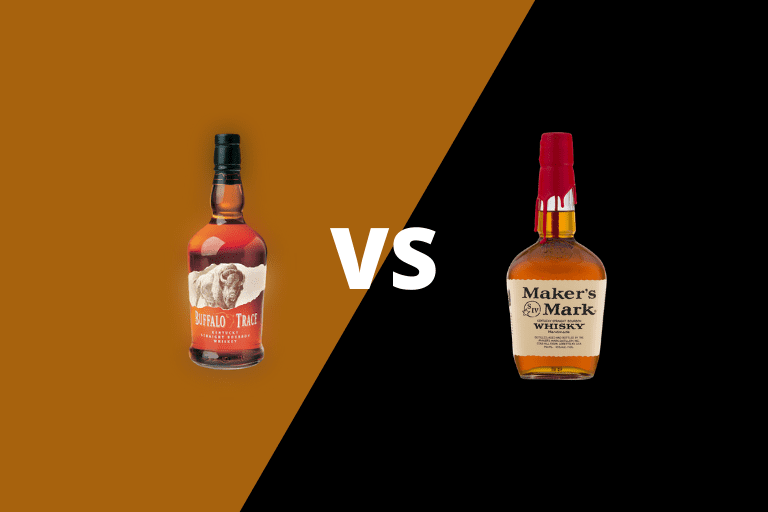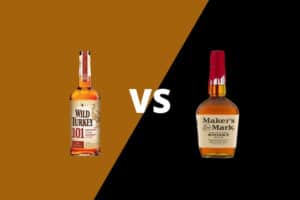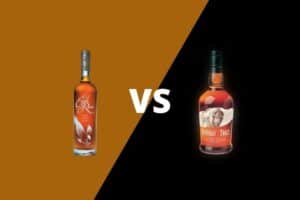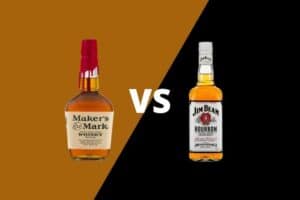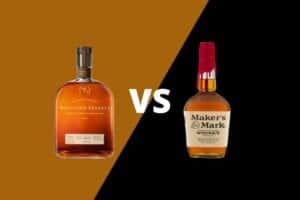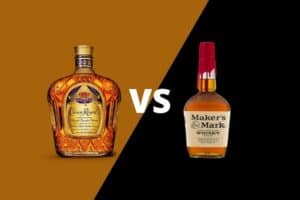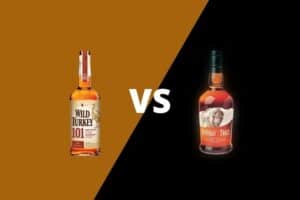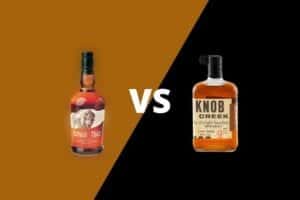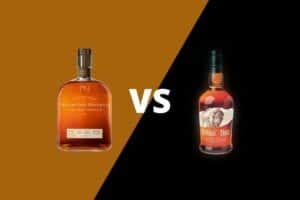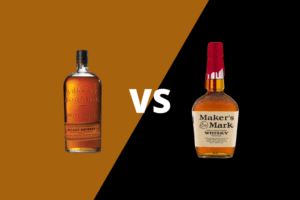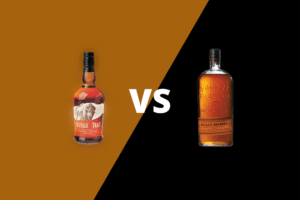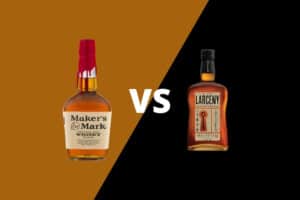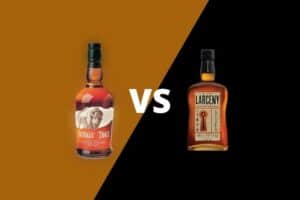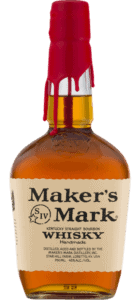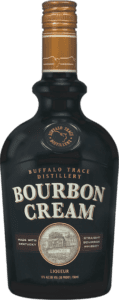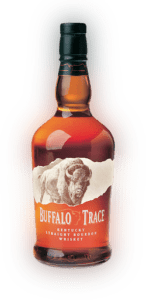Buffalo Trace and Maker’s Mark are two of the most easily recognized and well-respected names in the world of Kentucky Bourbon. But name recognition alone isn’t helpful if you’re trying to decide which one will taste best.
Deciding between these two bourbons may be a tricky proposition for someone new to the bourbon category. There may not be a lot on the label to give the reader very much information about flavor. But a closer outlook at these two industry-leading American whiskeys offers two dramatically different approaches to bourbon making — choices that offer wildly distinct flavors for you to discover.
Whether you are new to the bourbon category or a well-established whiskey enthusiast, there is plenty to learn by taking a look at these two remarkable brands. So, let’s peel back the labels and get to the juice inside these bottles by pitting Buffalo Trace and Maker’s Mark in a head-to-head competition.
Table of Contents
Round 1: History
Both brands have played essential roles in the growth of the Bourbon category.
Maker’s Mark founder Bill Samuels, Sr., purchased the Burk’s Distillery in 1954. He soon began making whiskey in the Loretto, Kentucky, distillery. But it was Marjorie — Bill’s wife — who had the eye for marketing and introduced innovations that are still recognizable to Maker’s Mark fans today. Marjorie’s influences include the unique bottle shape, label, wax seal and insignia — hallmarks that earned her a place in the Bourbon Hall of Fame alongside Bill. When Bill Senior retired, he handed operations to his son Bill Samuels, Jr. Today, Bill Junior’s son, Rob Samuels, is chief operating officer of the Maker’s Mark brand.
The Buffalo Trace website marks the history of the distillery back to 1775. But the Buffalo Trace Bourbon brand we are familiar with launched in 1999. The historic distillery in Leestown, Kentucky, was known for decades as the George T. Stagg Distillery before Sazerac purchased it.
Both of these brands claim to be made at the oldest distillery site in the United States. While each has a valid claim to the title for various reasons, let’s just agree that they’re both made at sites that are very important places in bourbon history.
Round 1 was given to Maker’s Mark in a split decision. Both brands have played a vital role in the popularity Bourbon enjoys today and are produced at historical distillery sites. The judges gave Maker’s Mark a narrow decision due to the brand’s earlier introduction to the marketplace.
Round 2: Ownership
Today, Maker’s Mark is owned by Beam-Suntory, the third-largest producer of distilled spirits on the planet. The path from a family-owned brand to being part of the Beam-Suntory portfolio is rather long. The brand was purchased by Hiram Walker & Sons in 1981, which was itself acquired by international spirits producer Allied-Domecq in 1987. Then, Allied Domecq was purchased by Pernod-Ricard, which spun Maker’s Mark off to Fortune Brands, which dissolved its spirits portfolio to form Beam Inc., which Suntory purchased in 2014. Got it?
Today, Buffalo Trace is owned by Sazerac. It was launched in 1999, shortly after Sazerac changed the name of the site from the George T. Stagg to the Buffalo Trace Distillery.
Round 2 is a draw. This may be an obscure reference, but has anyone ever watched the opening scene in the movie ‘Baseketball?’
Round 3: Mashbills
The mash bills may represent the most significant divergence of these two iconic bourbons.
Maker’s Mark is described as a wheated bourbon, while Buffalo Trace is often called a high-rye bourbon. Both of these terms describe the makeup of the mashbill, or mash recipe.
By law, all Bourbon whiskeys must be made from fermented grain — and at least 51 percent of those grains must be corn. Whiskey makers can determine the makeup of the remaining grain.
Maker’s Mark uses soft, red winter wheat to fill out the mash bill. Buffalo Trace uses a high percentage of spicy rye grain in their mash. The result is two wildly different flavors off the still.
Round 3 is also a draw. While many people stand on one side or the other of the wheated vs. high-rye debate, it’s really a matter of personal taste.
Round 4: Maturation
Both of these brands are NAS — No Age Statement bourbon whiskeys. That means they do not have an age statement on the label. Age statements are an important indicator of quality for consumers because distillers are legally required to be able to prove each barrel was matured for no less than the number of years indicated on the label.
However, each of these bourbons is bottled as a ‘Kentucky Straight Bourbon Whiskey.’ The ‘Straight’ designation means each barrel was matured for no less than two years in charred new American oak barrels.
Round 4 is a draw. There is no way for the average customer to determine the precise age of either of these whiskeys.
Round 5: Distillation & Production
Both Maker’s Mark and Buffalo Trace are made using modern, high-volume distillation practices. Both are made on a column still using Kentucky’s world-famous limestone filtered water. And, they both happen to be distilled at two of the oldest active distilleries in the United States!
One interesting feature of Maker’s Mark is the ‘Handmade’ reference on the label. There were some fascinating court hearings regarding a similar claim made by Tito’s Vodka brand. Without going into detail, it should be noted that the U.S. Alcohol and Tobacco Tax and Trade Bureau that regulates alcohol labels does not consider ‘handmade’ to be a signifier of any particular production technique.
Round 5 is also a draw. Both of these brands are generally respected as high-quality bourbons throughout the industry.
Round 6: Price Point & Value
Maker’s Mark retails for about $30 for a 750mL bottle, and is bottled at 90-proof, or 45 percent alcohol by volume.
Buffalo Trace will set you back about $27 for a 750mL bottle, and is also bottled at 90-proof, or 45 percent ABV.
Although they are in the same price range, the judges give the edge to Buffalo Trace for offering a slightly better value.
Round 7: Tasting Notes
Buffalo Trace Bourbon
Nose: Complex aroma, with notes of oaky wood barrel flavors, leather, tobacco and hints of vanilla.
Palate: Wide range of flavors. Bold, spicy rye character with black pepper and walnut notes.
Finish: Spicy and earthy, with lingering toffee and notes of cinnamon.
[Related: Complete Buffalo Trace Bourbon Review]
Maker’s Mark Bourbon
Nose: New oak and cherry aromas, with honey, soft wheat and malted cereal notes.
Palate: Sweet honey, vanilla, maple syrup and almond flavors.
Finish: Lingering maraschino cherry, chocolate, clove and baking spices.
[Related: Complete Maker’s Mark Bourbon Review]
Verdict…
After a tightly-contested matchup, this contest was ruled a toss-up! The judges were split into two camps: the signature smooth wheated flavor of Maker’s Mark on one side, and others leaning towards Buffalo Trace’s high-rye character and lower price-point.
The judges’ split reflects the opinions of the greater whiskey community. There is no lack of passionate fans of each brand. And neither side is wrong.
In fact, if you haven’t tried both of these American whiskeys, there’s really no way to judge which is the better offering. So, grab a glass of each of these excellent bourbons the next time you are at your favorite whiskey bar or spirits shop and see for yourself which is your champion!

